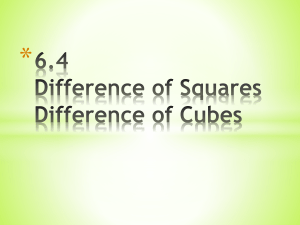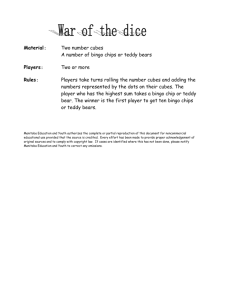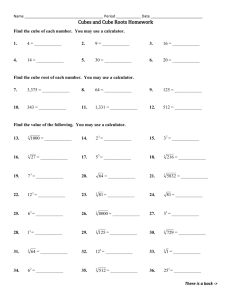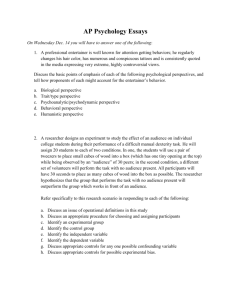Feedback on Tk20: Nice Job! Math Unit Classroom Description
advertisement
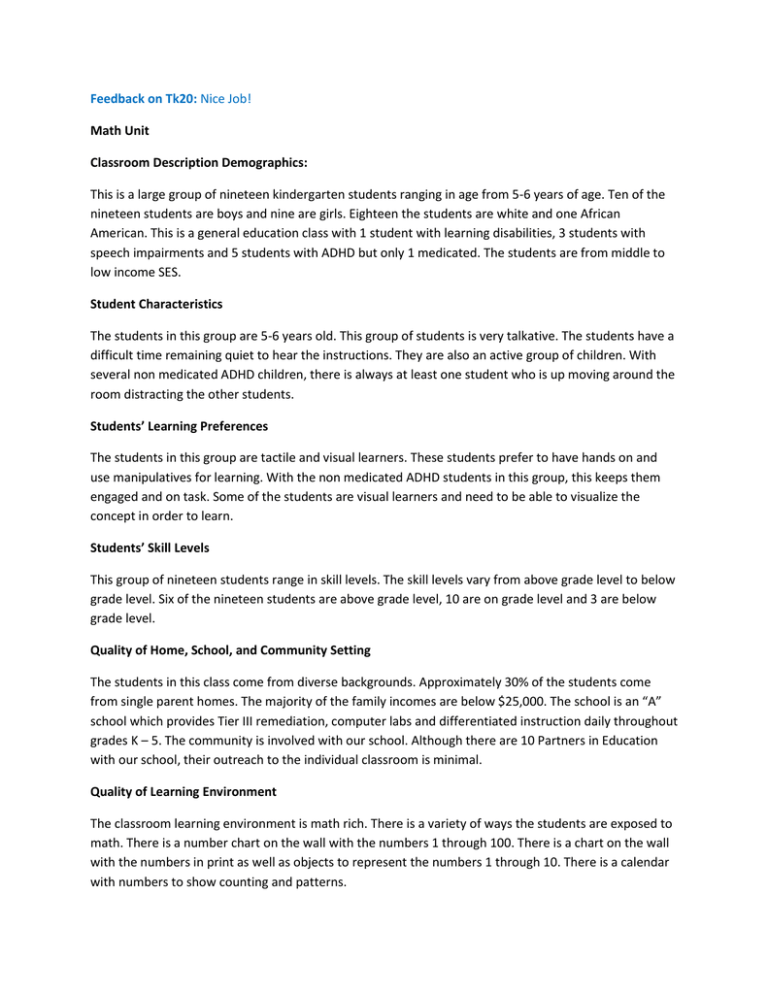
Feedback on Tk20: Nice Job! Math Unit Classroom Description Demographics: This is a large group of nineteen kindergarten students ranging in age from 5-6 years of age. Ten of the nineteen students are boys and nine are girls. Eighteen the students are white and one African American. This is a general education class with 1 student with learning disabilities, 3 students with speech impairments and 5 students with ADHD but only 1 medicated. The students are from middle to low income SES. Student Characteristics The students in this group are 5-6 years old. This group of students is very talkative. The students have a difficult time remaining quiet to hear the instructions. They are also an active group of children. With several non medicated ADHD children, there is always at least one student who is up moving around the room distracting the other students. Students’ Learning Preferences The students in this group are tactile and visual learners. These students prefer to have hands on and use manipulatives for learning. With the non medicated ADHD students in this group, this keeps them engaged and on task. Some of the students are visual learners and need to be able to visualize the concept in order to learn. Students’ Skill Levels This group of nineteen students range in skill levels. The skill levels vary from above grade level to below grade level. Six of the nineteen students are above grade level, 10 are on grade level and 3 are below grade level. Quality of Home, School, and Community Setting The students in this class come from diverse backgrounds. Approximately 30% of the students come from single parent homes. The majority of the family incomes are below $25,000. The school is an “A” school which provides Tier III remediation, computer labs and differentiated instruction daily throughout grades K – 5. The community is involved with our school. Although there are 10 Partners in Education with our school, their outreach to the individual classroom is minimal. Quality of Learning Environment The classroom learning environment is math rich. There is a variety of ways the students are exposed to math. There is a number chart on the wall with the numbers 1 through 100. There is a chart on the wall with the numbers in print as well as objects to represent the numbers 1 through 10. There is a calendar with numbers to show counting and patterns. Specific student learning outcomes for unit that align with national and state standards The students will be able to use indirect comparison to compare length, to measure lengths using nonstandard units, and use the problem solving strategy estimate and measure to solve problems. Given a list of 8 classroom objects and 15 cubes, the students will use the cubes to measure the objects with 90% accuracy. MA.B.1.1.2.K.1 The student uses standard customary and metric (centimeter, inch) and nonstandard units, such as links or blocks, in measuring real quantities. GLE – Uses nonstandard objects, such as cube, marbles, paper clips, and pencils, to measure classroom objects (for example, table length is 10 crayons or four pencils). Given a list of 4 objects, not side by side, and two different colors of yarn, students will use the yarn to compare the length of the objects with 100% accuracy. MA.B.2.1.1.K.2 The student uses direct (measured) and indirect (not measured) comparisons to order objects according to some measurable characteristics (length, weight). GLE - Uses indirect comparisons to compare lengths of objects that cannot be physically compared (sideby-side) (for example, compares height of counters in classroom and cafeteria by using string or in reference to child’s own body). Assessment Plan Screening Students will be given a worksheet, What is My Measurement, which contains measuring a variety of objects using both direct and indirect comparisons. Progress Monitoring The progress monitoring for this skill will be assessed by teacher observation of the students’ participation in the daily measuring activities. Progress will also be assessed by the students’ individual completion of the workbook pages. Progress will also be assessed based on the responses the students have to the teacher asked questions. For example, what are you measuring?, Where do you put the end of the cube or yarn to measure the length of the object? How do you compare the length of two pieces of year? How do you know which is longer? How does comparing the two pieces of yarn help you decide which object is longer or shorter? Outcome-based Assessment Students will be assessed by giving a post test at the end of the unit based on the math book assessment pages 229-230. Instructional Plan Addresses all 5 areas of reading: phonemic awareness, phonics, vocabulary, fluency, comprehension. OR Skill based unit (dependent on topic) addresses concept building, mechanics, and knowledge application; (real-world problems, dependent on topic, etc.) Monday – The teaching will consist of using direct comparison to order objects by their lengths. I will introduce the terms shortest and longest. I will draw three short lines of different lengths on the board so that they align and have the same starting point. I will point to each line in order from longest to shortest and state this is a short line, this one is shorter and this is the shortest. I will repeat the procedure but drawing three long lines and using the terms long, longer and longest. I will model using three crayons of different lengths and ask the students to tell which object is the shortest and which is the longest. The students will complete a worksheet ordering the objects from shortest to longest. Tuesday – The teaching will consist of using indirect comparison to compare length. The students will be provided with two different colors of yarn. I will model how to measure using the yarn. I will measure two different objects that are not side by side each with a different color yarn. I will hold up the two pieces of yarn. I will ask the students which yarn is longer. I will ask so which object is longer? I will provide and model several examples. The students will practice using yarn to compare the length of objects in the classroom and then complete the worksheet using the yarn to measure the pictures and circle the one that is the longest. Wednesday– The teaching will consist of measuring lengths using nonstandard units. The term measure will be introduced with the meaning. I will introduce the concept by taping a pencil horizontally to the board and draw a vertical line at each end. I will model measuring the pencil with connecting cubes. I will ask for a volunteer to count the cubes and tell how many cubes long the pencil is. The students would then practice by placing cubes on objects and counting to see how many cubes long each object is. I would remind the students of the importance of lining up the cube at the beginning or end of the object with no gaps between the cubes. Thursday – The teaching will consist of using the problem solving strategy estimate and measure to solve problems. I will introduce the vocabulary word estimate and meaning. I will hold up a book and ask about how many paper clips long is this book? The children will look at the book and write down their estimates. Then I will have a student volunteer to use paper clips to measure the book. I will remind the students about the importance of placing the paper clips end without gaps. The students will practice by estimating the number of paper clips of different objects and then measuring with paper clips and then count the paper clips for a measurement and then compare their estimate with the measurement. Friday – This teaching will consist of a review to check understanding of the concepts, skills and problem solving presented. The students will also be given the unit assessment on pages 229-230. Differentiated Instruction: List specific activities, strategies or techniques used to provide instruction for diverse students, including ESOL students. Please list this information here even if you wrote it into the plans above. Instruction will be differentiated for above grade level students by having them measure straight and wavy lines with the yarn. For the below grade level students, the students will use the connect cubes to use indirect comparison. The students will connect the cubes to match the lengths of two large classroom objects. They will place the cube trains side by side to determine which is longer, recall which object matched the longer train, and name the longer object. ESL strategy –The students will be provided connecting cubes, paper with several lines of different lengths with starting and ending points shown. I will model measuring the first line. Connect five cubes. I am putting one end of this train at the starting point. Now I can count the cubes until I reach the other end. Add or remove cubes to match the ending point and have the students count with you. This line is five cubes long. Reflection Students are identified in the graph by numbers. Each student was assigned a number for the purpose of this test and to keep the confidentiality of identity. All 19 students were given a math pretest and post test for the unit on the concept of measurement. The graph indicates the students’ number of questions answered correctly on both the pre and post math tests. The graph shows each students performance in their knowledge of the skill and concept of measurement. The pretest shows the students lack of knowledge with the concept and skill of measurement. The post test shows students growth with their understanding with the math concept of measurement. The students were able to spell the words using sounds and blends. The post test indicates the students’ demonstrated growth in their performance with the math concept of measurement. The students were able to accurately measure different objects and determine which object is longer, shorter, wider, and thinner. Students limited math skills and understanding of measurement concept prior to this unit indicated a problem with measuring and comparing different objects. After practicing measuring using yarn and different objects around the classroom, the post spelling test indicates the majority of the students have mastered measuring by correctly measuring and comparing objects and indentifying which object were shorter, longer, wider, taller and thinner. This plan was effective because it provides a foundation for the students’ future math success. It provided real world experiences the students could use to make indirect comparisons of different objects. The students need to have measuring skills to be able to estimate and solve problems in real world situations. To improve the assessment I would provide the students with more exposure, practice and time with the measuring skill and concept. I would also allow the students to explore and not rush through the unit. I would also have the students use different measuring tools, such as paper clips, pencils, cubes, and hands. This plan was effective because it provides a foundation for the students’ future math success. It provided real world experiences the students could use to make indirect comparisons of different objects. The students need to have measuring skills to be able to estimate and solve problems in real world situations. To improve the assessment I would provide the students with more exposure, practice and time with the measuring skill and concept. I would also allow the students to explore and not rush through the unit. I would also have the students use different measuring tools, such as paper clips, pencils, cubes, and hands.



